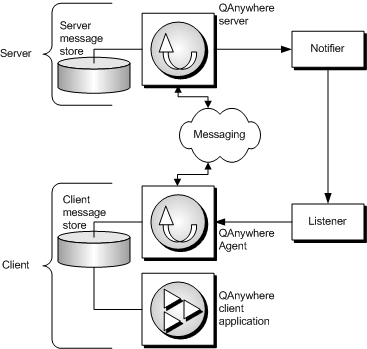A push notification is a special message delivered from the server to a QAnywhere client. The push notification occurs when a message arrives at the server message store. The messaging server automatically notifies the recipient client Listener of the push request. The client initiates message transmission to receive messages waiting at the server or takes a custom action.
For more information about the client's response to a push notification, see Determining when message transmission should occur on the client.
Push notifications introduce two extra components to the QAnywhere architecture. At the server, a QAnywhere Notifier sends push notifications. At the client, a QAnywhere Listener receives these push notifications and passes them on to the QAnywhere Agent.
If you do not use push notifications, messages are still transmitted from the server message store to the client message store, but the transmission must be initiated at the client, such as by using a scheduled transmission policy.
The architecture for messaging with push notifications is an extension of that described in Simple messaging scenario. The following diagram shows this architecture:

The following components are added to the Simple messaging scenario to enable push notification:
QAnywhere Notifier The Notifier is the component of the MobiLink server that is used to deliver push notifications.
The QAnywhere Notifier is a specially configured instance of the Notifier that sends push notifications when a message is ready for delivery.
Listener The Listener is a separate process that runs at the client. It receives push notifications and passes them on to the QAnywhere Agent. QAnywhere Agent policies determine if push notifications automatically cause message transmission.
See Determining when message transmission should occur on the client.
| Send feedback about this page via email or DocCommentXchange | Copyright © 2008, iAnywhere Solutions, Inc. - SQL Anywhere 11.0.0 |